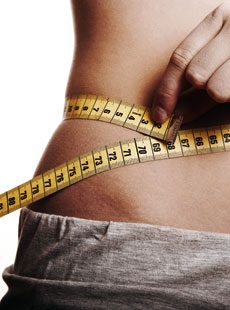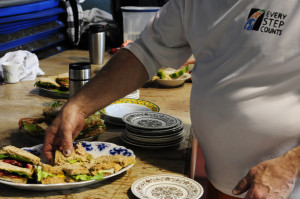Nutrition talk: Getting light on your feet

From a “calories in – calories out” perspective, one night of drunken gluttony can undo 30k worth of running. I know, because sometimes I do just that – and I’m not alone. Running along the Bow River in Calgary during the summer months, it’s clear that many of my fellow rapidly travelling bipeds haven’t mastered the concept of caloric restriction. In other words, some guys really need to keep their shirts on.
As a fitness author I feel the need to look the part, so while I do love running, I also like the fact that it burns a lot of calories and makes it so that I can see my abdominal muscles (as long as the lighting is good and I twist the right way). However, running is only part of the equation. I’m a 41-year-old guy who likes beer,soIneedtowatchwhat–andhowmuch–Ieat.Itcanbe a fine balance, because losing fat means taking in fewer calories than you burn, on a regular basis, and if done improperly this can decrease performance and cause hunger – and being hungry sucks. The proper way to restrict calories is pretty simple: focus mostly on eating healthy food, don’t stuff yourself, but don’t let yourself starve either.
Let’s tackle healthy food first. The general consensus by registered dietitians boils down to focusing on unprocessed carbohydrates as a main source of calories, and this means lots of fresh fruits and vegetables and whole grains. If nature made it that way then go big, but if people processed the crap out of it then stay away. RDs also recommend limiting trans and saturated fats, eating less red meat, and moderating alcohol intake. The first reason for eating healthy should be obvious: it keeps your body healthy. Crappy food equals crappy health. The second reason is a matter of performance. Think of your body as a sports car: you need to put high-octane fuel in it to get high performance. Junk food is low octane and will make you drag your butt.
 From a weight loss perspective, healthy food is your friend because it controls appetite far better than junk does. A lousy diet is one that is high in calories, but low in many of the nutrients that are vital to bodily function. Active people especially require these nutrients, so even after a Doritos/Big Mac/large Coke with a side of Timbits festival of pigging out your body can send out hunger signals a short time later because it isn’t getting what it needs to perform. Conversely, consuming fruits and vegetables, whole grains, lowfat dairy and lean meats gives a healthy dose of what you need to thrive. Your body’s hormonal reaction from a hunger perspective is: “Thanks for that. We’re good.”
From a weight loss perspective, healthy food is your friend because it controls appetite far better than junk does. A lousy diet is one that is high in calories, but low in many of the nutrients that are vital to bodily function. Active people especially require these nutrients, so even after a Doritos/Big Mac/large Coke with a side of Timbits festival of pigging out your body can send out hunger signals a short time later because it isn’t getting what it needs to perform. Conversely, consuming fruits and vegetables, whole grains, lowfat dairy and lean meats gives a healthy dose of what you need to thrive. Your body’s hormonal reaction from a hunger perspective is: “Thanks for that. We’re good.”
Another major benefit to eating healthy food is the high volume-to-calorie ratio. An extreme example is comparing a large, one-pound bag of spinach to a single Oreo cookie. Believe it or not, they both have about the same number of calories. Now I can pack away plenty of Oreos, but I’m not sure how many pounds of spinach I can eat before I’m stuffed and ready to poop out algae. This same rule applies to eating fat – both the good and bad kinds – because of its caloric density. Fat has nine calories per gram, whereas carbohydrates and protein each only contain four per gram. The result is that eating fat results in high doses of calories for less volume and weight of food.
Generally speaking, the healthier the food the lower its caloric density, and many researchers have found that such foods are much more satisfying. For example, a 2005 article in the American Journal of Clinical Nutrition found that focusing on eating low- caloric density foods was a powerful tool for losing weight. A 2006 article in the same journal agreed, stating that people who ate lots of fruits and vegetables actually got to eat more food by volume and weight, but consumed fewer calories and therefore achieved more weight loss.
The food recommendations above will help in limiting overall caloric intake, but so will several other tips that allow you to lose weight while at the same time ensuring you’ve got the energy you need to wear out the soles of your runners. One lesson is to learn the difference between “satisfied” and “full,” and focus on doing the former. There is an old Chinese adage that says, “Eat until you are eight-tenths full.” If you’re concerned about your waistline, then it’s good advice to follow. Not stuffing yourself is important if you want to lose weight, but you also need to make sure you’ve got fuel for your runs. It’s no fun when you’re kilometres from home and suffering from a low-blood-sugar attack. I once begged a cereal bar from a hiker when this happened to me. Talk about embarrassing.
The final bit of advice is to only go hungry at the end of the day. Eat breakfast, eat lunch, eat dinner, and then stop. Keep a moderate intake of food throughout the day so that you have energy and can resist the late-evening ice cream frenzy. Avoid the before-bed snack whenever possible. Instead, drink some tea, chew some gum, brush your teeth, stretch, go to bed and sleep, or go to bed and do other stuff. Do anything but eat. This has nothing to do with metabolism and everything to do with not scarfing another 500 calo- ries before going to sleep.
Remember that every calorie ingested has to be burned, so if you went through a medium pizza and a six-pack last night, then go lace up those shoes and get it in gear.


